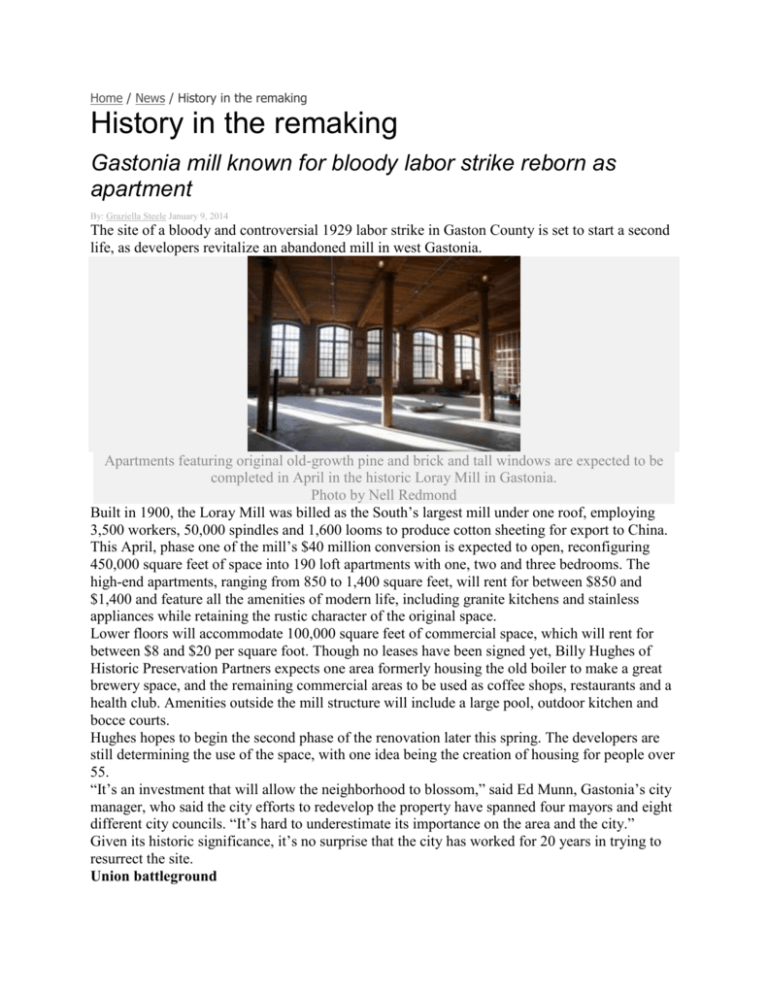Mecklenberg Times - Historic Preservation
advertisement

Home / News / History in the remaking History in the remaking Gastonia mill known for bloody labor strike reborn as apartment By: Graziella Steele January 9, 2014 The site of a bloody and controversial 1929 labor strike in Gaston County is set to start a second life, as developers revitalize an abandoned mill in west Gastonia. Apartments featuring original old-growth pine and brick and tall windows are expected to be completed in April in the historic Loray Mill in Gastonia. Photo by Nell Redmond Built in 1900, the Loray Mill was billed as the South’s largest mill under one roof, employing 3,500 workers, 50,000 spindles and 1,600 looms to produce cotton sheeting for export to China. This April, phase one of the mill’s $40 million conversion is expected to open, reconfiguring 450,000 square feet of space into 190 loft apartments with one, two and three bedrooms. The high-end apartments, ranging from 850 to 1,400 square feet, will rent for between $850 and $1,400 and feature all the amenities of modern life, including granite kitchens and stainless appliances while retaining the rustic character of the original space. Lower floors will accommodate 100,000 square feet of commercial space, which will rent for between $8 and $20 per square foot. Though no leases have been signed yet, Billy Hughes of Historic Preservation Partners expects one area formerly housing the old boiler to make a great brewery space, and the remaining commercial areas to be used as coffee shops, restaurants and a health club. Amenities outside the mill structure will include a large pool, outdoor kitchen and bocce courts. Hughes hopes to begin the second phase of the renovation later this spring. The developers are still determining the use of the space, with one idea being the creation of housing for people over 55. “It’s an investment that will allow the neighborhood to blossom,” said Ed Munn, Gastonia’s city manager, who said the city efforts to redevelop the property have spanned four mayors and eight different city councils. “It’s hard to underestimate its importance on the area and the city.” Given its historic significance, it’s no surprise that the city has worked for 20 years in trying to resurrect the site. Union battleground One of the few sites in the state recognized by the National Register as being of national significance, the mill was important due to its advancement of industrialization in the state, its implications to the national labor movement and its impact on North Carolina politics for decades, said Myrick Howard, president of Preservation North Carolina, which acquired the mill in 1998. The imposing six-story, 600,000-square-foot building with an eight-story, 140-foot Italianate tower was the site of an attempt by Northern union organizers looking to gain a foothold in a region that had previously resisted organized labor. After the mill’s ownership changed hands, plant workers in the late 1920s were bristling at being required to produce more work in the same amount of time without an increase in pay. Seizing on the opportunity, union leaders were able to get many plant workers to organize. A standoff ensued for months when 1,800 workers walked off the job in the spring of 1929 and owners refused to negotiate. Mill workers were evicted from their homes. The governor called in the National Guard to keep order. Events escalated until June 7, when police were brought in to break up the picket lines, shots were fired and the Gastonia police chief was killed. Sixteen workers were tried for the shooting death of the police chief that fall, but were later released when a mistrial was declared after a juror went insane during the trial. While no unions were formed in North Carolina following the unrest, the events did result in focusing national attention on the plight of mill workers. After the market in China dried up, the mill then turned to manufacturing cord for tires, a product it made until its closing in 1992. With improvements in mechanization, the “Million Dollar Mill” had run its course with Firestone, the owner, moving its operations into a new one-story plant in Kings Mountain. Preservation perseverance The city’s 20-year quest to revitalize the property has been a labor of love and persistence. During that time, three different developers approached the city to redevelop the mill and surrounding village, but plans never fully played out because of funding problems. The mill was on the verge of demolition when Firestone was talked into donating the plant to Preservation North Carolina, a private nonprofit that protects important local heritage sites. A team of developers out of California and Atlanta first became interested in the redevelopment project in 2004. “I saw the tower about a mile away from the plant and said to myself, ‘This is a tremendous project’,” said Hughes of his reaction upon first driving to the site. Hughes said the team early on was able to secure funding from Freddie Mac, but then the recession hit and the loan never materialized. Hughes and his partners persevered, finally obtaining a $22 million loan from a lender, Berkadia, backed by the Federal Housing Administration. That, in addition to federal and state tax credits to encourage mill conversions, is funding the reinvention of the old mill. The structure retains its old-growth pine pillars, pine ceilings, six-inch wood floors, original fire doors and exposed brick surfaces. The airy and bright space also features 582 custom windows that run almost floor to ceiling, interior brick archways and cutouts to lower floors. The apartments will have 16-foot ceilings on the lower level and soar to 20 feet on the top floor, with expansive views of the Charlotte skyline, Crowders Mountain and downtown Gastonia. There’s also a shared area among the apartments where residents can socialize. Redevelopment vision Jack Kiser, Gastonia’s former executive in charge of special projects, believes the mill’s rehabilitation will have a catalytic effect on the surrounding area, rejuvenating the entire west side of the city. Munn too expects a “transforming effect on the neighborhood and center city.” Improvements to the area are already being seen, with the private sector raising money to create a public park in the neighborhood just last month. Preservation North Carolina also just obtained from the city of Gastonia two historic bungalows in the Loray Mill Historic District that served as housing for mill workers at the foot of the factory. “Our goal is to assist in the rehabilitation of adjacent structures to the mill,” said Ted Allen with Preservation North Carolina. To that end, the nonprofit will maintain the homes until it identifies buyers willing to fix them up. The bungalows are part of a 435-unit village, and the nonprofit believes that with rehabilitation, homeowners will follow suit and revitalize the area. “The hope is that the mill in particular will create a revival of interest for homeownership in the mill village,” said Howard. Preservation North Carolina points to the revitalization that occurred at two mill and village projects that it helped rehabilitate in Edenton and Glencoe. Munn said it’s still too early to gauge the impact of the redevelopments in the community. He anticipates new housing will be built on vacant properties, and work will continue to upgrade existing homes. “Neighborhoods improve over a period of time. Come back to visit in 3 or 4 years.” Graziella Steele Reporter, The Mecklenburg Times Your Inside Source for Real Estate, Development and Construction Information Office: 704.247.2911 Mobile: 201.965.0375







